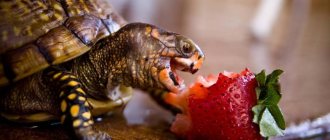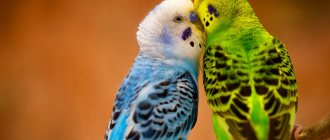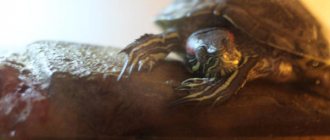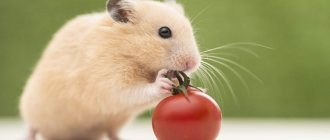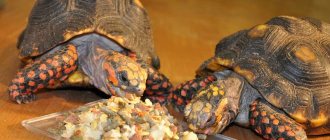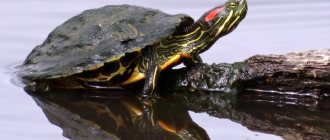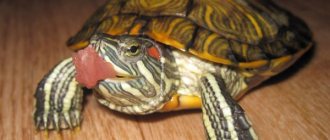It is necessary to feed a land turtle at home correctly; the diet must be complete and balanced. After all, high-quality food is the key to a long and healthy existence for a pet.
- 1 Food in natural habitat
- 2 Feeding characteristics of species 2.1 Omnivores
- 2.2 Herbivores
Food in natural habitat
In the wild, land turtles obtain their own food. This is, for the most part, plant food - grass, plant roots, berries, algae from the edges of reservoirs. Some part of the diet of wild turtles is protein food. These are worms, small insects, small snails.
The peculiarity of this reptile is that it can remain without food for quite a long time, storing significant reserves of it in its body during favorable seasons.
These animals are well versed in what vitamins, micro- and macroelements they lack at a certain stage of life and successfully find the products they need in the animal and plant world.
Feeding features of the species
All natural species of turtles are divided according to their feeding method into three large orders:
- predatory;
- herbivores;
- omnivores.
Each of them has their own list of food products necessary for a full-fledged existence. But among the land species of turtles there are no predators, so it is important to consider only the diet of herbivores and omnivores. When purchasing these pets, it is imperative to find out what type of food they belong to.
The omnivorous species that are suitable for keeping at home and most often found in the world are the Mediterranean, musk, flat and Balkan.
Mediterranean
musky
Balkan Flat
Herbivores include star, Indian, Central Asian, Egyptian, serrated, red-headed, radiated, Galapagos.
Indian
Star-shaped
Galapagos Radiant
Redhead
Serrated Egyptian
Central Asian
Omnivores
Their diet must necessarily consist of live food, for example:
- mice and small rats;
- frog;
- snails;
- insects - tubifex, bloodworms, daphnia, beetles, caterpillars, worms;
- slugs;
- fish and seafood.
The plant part of the diet should contain:
- vegetables;
- fruits;
- berries;
- aquatic plants;
- various herbs.
Herbivores
80% of the diet of these land turtles should be products of plant origin - various salads and spinach (leafy part), dandelion, cabbage.
Additional food:
- vegetable crops - pieces of carrots, cucumbers, zucchini, tomatoes, sweet peppers;
- fruits - apples, pears, peaches, apricots, bananas, citrus fruits;
- berries - cherries, raspberries, strawberries, grapes, currants, watermelon;
- other herbs - coltsfoot, sorrel, plantain, alfalfa, legumes;
- mushroom crops, such as champignons;
- special prepared food;
- bran and flakes from plant crops, sunflower seeds.
We recommend reading the article on what to feed pet turtles.
Omnivores
Despite the name, semi-aquatic and marsh turtles are the most demanding in terms of food composition. In addition, their diet can change significantly during the period of growing up.
The optimal composition of the diet depends solely on the type of turtle. In addition, it is necessary to determine how many times to feed small turtles, whose main diet consists of food of animal origin.
Home Diet Basics
At home, a land turtle does not have the opportunity to independently choose food, obtaining those products that its body needs at a particular moment. In addition, natural instincts are gradually dulled, which is manifested, for example, by the fact that it begins to absorb earth and small stones. Therefore, the owner of the reptile is responsible for the correct and balanced diet of the pet.
In order to prevent imbalances in nutrition, which can cause various diseases, it is recommended to keep a weekly diary of your pet’s nutrition. It creates a daily menu with the correct distribution of doses of vitamin supplements, calcium and amino acids.
The most correct diet would be the following ratio of products:
- herbs, greens - up to 75-80%;
- vegetable and fruit crops, berries - 10-15%;
- cereals, seeds, bread - up to 5%;
- vitamin supplements, micro- and macroelements, animal proteins, amino acids - up to 5%.
As herbs, the greatest preference should be given to the following plant crops:
- dandelion and lettuce (leaves);
- beans, peas, beans (stems and leaves);
- alfalfa;
- plantain;
- clover;
- parsley;
- aloe;
- lawn forbs;
- thistle;
- sorrel;
- sprouted wheat and oat sprouts;
- some flowering plants.
All types of land reptiles love vegetables:
- pumpkin pieces;
- fresh chopped carrots;
- small leaves of young cabbage;
- mature chopped zucchini, squash, cucumbers;
- radishes and beets - only in young fresh form.
It is advisable to give your pet pieces of apples or pears every day, and occasionally watermelon, strawberries, strawberries, raspberries, currants, peaches, and apricots.
All stone fruits are cored and the products themselves are cut or torn into small pieces.
As a protein component, you can give both worms, insects, snails, and small pieces of boiled or raw meat.
An approximate menu for the day might look like this (in grams):
- sprouted sprouts (for example, wheat) - 50;
- raw young beets, chopped - 30;
- chopped white cabbage leaves - 30;
- chopped boiled potato tubers - 30;
- raw minced beef or chicken or earthworms - 5-10;
- pieces of wheat bread - 25;
- fish oil, vitamins, microelements - 1-3.
It is necessary to give foods containing calcium a couple of times a week. For example, cottage cheese mixtures, cereal porridges - buckwheat, milk semolina or oatmeal.
At least once a week, the diet includes small quantities of seaweed, various bran, sunflower seeds, yeast, soybeans, mushrooms, and ready-made nutritional mixtures.
Ready-made dry food
Despite the assurances of some manufacturers about the complete self-sufficiency of the feed they produce, practice has shown that the optimal diet will be a combination of dry food and live feeding.
For example, if the diet of a fairly common red-eared turtle is dominated by live (especially fatty) fish, this is guaranteed to lead to an acute deficiency of vitamin E and the occurrence of steatitis.
Dry food that provides your pet with vitamin supplements in the proper quantities can lead to a significant lack of amino acids, which can lead to spasms of the jaw muscles - the turtle simply will not be able to open its mouth.
A balanced diet includes both factory-produced dry food and live food.
When choosing dry food for your pet, you need to take into account that some manufacturers' composition does not meet the animal's requirements.
As you can see in many photos of turtle food, the most common replacement is for animal products such as rather expensive fish and seafood with cheaper substitutes - fishmeal and various herbal additives.
Do land turtles need water?
These reptiles, like other animals, require water for normal functioning. In nature, they get it from the stems and roots of plants, and also drink it when swimming in ponds.
There is no need to install special drinking bowls for a domestic reptile, but regular bathing should be organized. For some species, weekly water procedures are needed, for others it is enough to carry them out once a month. But it is still optimal to bathe pets once a week, and even more often in the hot season.
It is enough to pour warm water into a small container, not lower than +25 °C, and lower the pet there so that the liquid covers the entire upper shell and reaches at least the middle of the neck.
For aquatic turtles
The optimal diet of an aquatic turtle is much more complex than that of a land turtle. It should be borne in mind that full-fledged live feeding is quite difficult here, since in nature such animals feed exclusively on fresh fish.
And seafood, which is offered in domestic stores, goes through cycles of freezing and thawing several times. This leads to the destruction of nucleic acid proteins, as well as oligoelements, which are vital for the predatory sea turtle.
Therefore, the addition of dry food saturated with appropriate microelements is a prerequisite for creating a complete diet. It is imperative to check whether the food contains fat-soluble vitamin complexes, of which vitamins A and E are considered the most popular.
Food in summer and winter
Summer feeding of land turtles is usually not difficult, because fresh herbs, vegetables, fruits, and berries can be easily picked or purchased.
Food should be prepared for the winter. Greens can be cut and frozen in the refrigerator, dividing them into daily portions. You can do the same with fruits and vegetables. Forbs can also be prepared in the form of hay.
If there are fish in the house, then you can plant an abundance of aquatic plants in the aquarium and feed your land pet with them in winter.
In the terrarium you can also install clay pots in which alfalfa, oats, wheat stalks, plantain, dandelion sprouts, and cultivated varieties of greens grow. All types of land turtles happily eat sprouted carrot tops.
How to feed
There are certain rules in the process of feeding a terrestrial reptile.
- Don't feed your pet often. The young are fed once a day during the day. Evening feeding is allowed, but always 3-4 hours before bedtime. Animals older than 2-3 years are switched to less frequent food - once every two days.
- You must feed the animals at the same time. Then the body will get used to this regime and will secrete gastric juice in excess. This promotes better digestion of food.
- Food should be served in small portions. These animals are not prone to overeating, so the pet’s nutrition is regulated by the owner himself. For example, if your turtle has leftover food after eating, feed it less.
- Stress will negatively affect your turtle's digestion. Don't bother her, make sharp noises.
- Do not hand feed your turtle.
Food in winter
At home, land turtles feel the change of winter and summer seasons. The daily diet also changes throughout the year. In summer, the reptile consumes juicy fruits and berries in abundance. With the onset of winter, the meager food of land turtles becomes more familiar to the body. Therefore, in the cold season, the diet consists of soaked hay and cereals. Fruits and roots should be less juicy.
Prohibited Products
There are foods that are contraindicated in the daily diet of reptiles. This list of foods causes various diseases in them, such as liver disease. When planning your diet, you must carefully select foods.
List of foods that should not be fed to turtles:
- Some insects (eg, crickets, grasshoppers, cockroaches).
- Some plants (onions, garlic).
- Fried, smoked and other human food.
- Some indoor plants (for example, ambulia, azalea, dieffenbachia).
- Milk product.
- Some herbs (eg spinach, spices).
- Cherry.
- Egg shells.
- The food is intended for other animal species.
- Peeled lemon, orange, tangerine.
- Potatoes are raw.
Also, do not feed your land turtle the same food every day. Animal nutrition must include all trace elements and essential substances, vitamins, and calcium.
Mr. Tail explains: foods prohibited for land turtles
The owner of these reptiles should be well aware of the foods that should never be given to pets:
- stone fruit seeds - apricots, peaches;
- citrus peel;
- plants that are poisonous and medicinal, such as buttercup, nightshade, potato and tomato tops, crocus, narcissus, milkweed, delphinium, hydrangea, mistletoe, dieffenbachia, azaleas, lilies, elodea;
- sausages and canned goods.
Porridge, baked goods, dairy products, eggs and eggshells, meat, onions, garlic, celery, spinach stems, radishes, and spicy herbs are allowed only in minimal quantities.
Feeding rules
It is advisable to eat at the same time every day, preferably in the morning.
When feeding turtles, you must follow simple rules:
- Up to a year of age they are fed every day, after two years they can be fed every other day.
- Food utensils should always be washed clean before each feeding.
- Portions should be made small, and excess should be removed from the terrarium so that it does not spoil.
- Try to ensure complete rest for your pet while feeding. The turtle is frightened by loud sounds and sudden movements.
- Reptiles should not be taught to eat from their hands. They very quickly get used to this method of feeding, and then refuse to eat from the bowl.
- You should not overfeed your pets, that is, give food too often, this can lead to obesity and distortion of the carapace and plastron.
- Feeding too infrequently is also unacceptable, as this can cause exhaustion and death.
Errors
- Feed your reptile too often. This will cause overeating and indigestion.
- The reptile body is adapted to consume a certain type of food. You cannot feed a herbivore only meat, and a carnivore only fruits and vegetables.
- Giving your pet food too rarely. The individual will be weak, lethargic, inactive and susceptible to disease.
If you follow the rules of feeding land reptiles, they will have good health and longevity.
Sources:
https://womanadvice.ru/chem-kormit-suhoputnuyu-cherepahu-zimoy https://myturtle.ru/chem-kormit-krasnouxuyu-cherepaxu/ https://rybkies.ru/obitateli/chem-kormit-suhoputnuyu-cherepahu -v-domashnih-usloviyah.html
